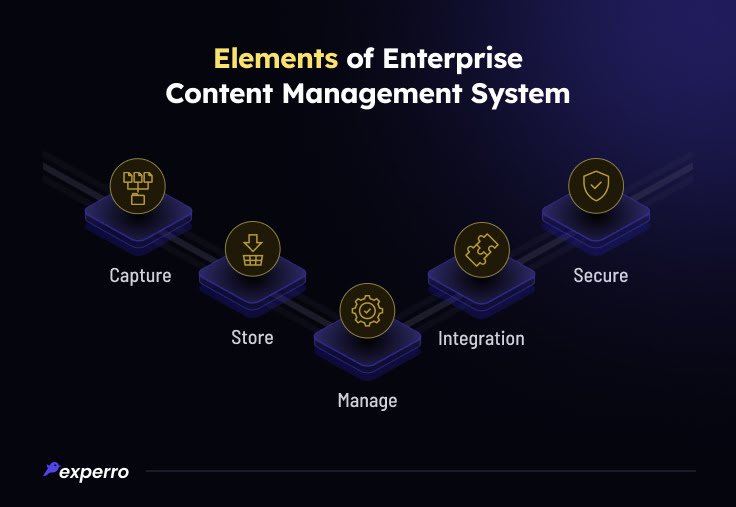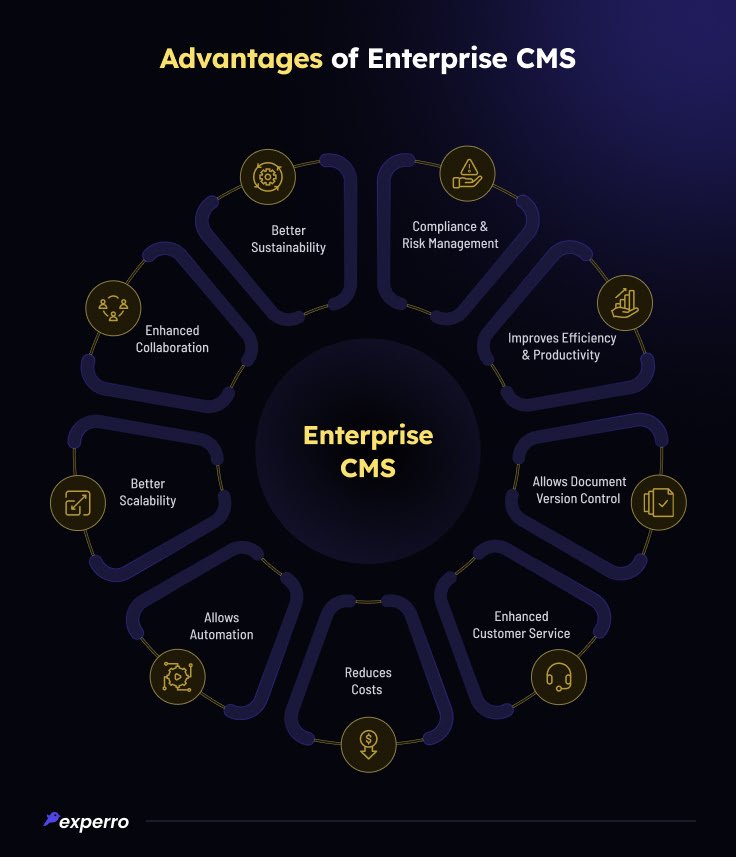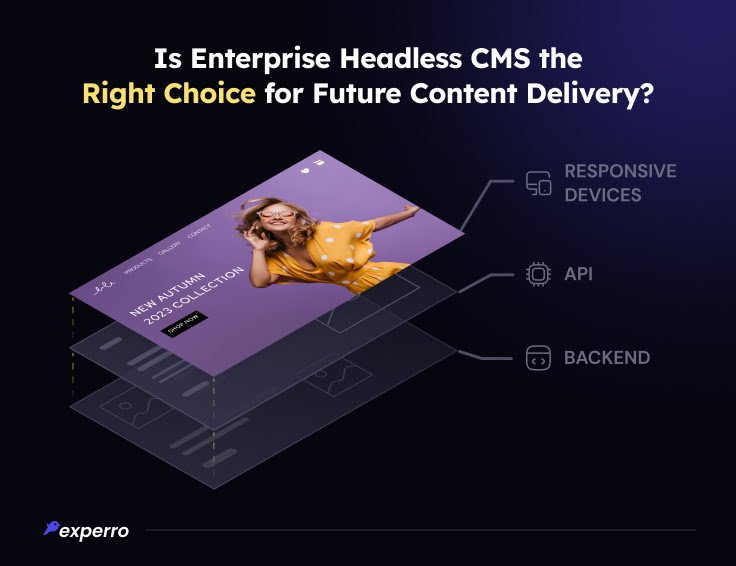How to Choose the Right Enterprise CMS in 2024?

What’s Inside
- What is Enterprise CMS?
- What is Enterprise Content Management? (ECM)
- How Does an Enterprise CMS Work?
- How to Choose the Best Enterprise Content Management System? (Know the Factors)
- What Are the Advantages of an Enterprise CMS?
- What Are the Steps to Implement an Enterprise CMS Solution?
- Use Cases of Enterprise Content Management System
- What Are the Challenges and Solutions of an Enterprise CMS?
- How Does Experro Redefine the Future of Headless Enterprise CMS?
- Conclusion
Key takeaways
- Enterprise CMS streamlines content management across digital platforms, enhancing efficiency
- Selecting the best CMS for enterprise involves matching the system to its content management objectives.
- Headless CMS offers unmatched flexibility and scalability for future-proof enterprise content strategies.
- Integration capabilities are key in choosing an enterprise web content management system.
- Experro excels in scalability and flexibility as the best enterprise CMS solution.
The amount of digital content is growing incredibly, including everything from documents and emails to audio, videos, and social media posts.
Traditional CMS platforms often struggle to meet the complex demands of larger organizations, leading to inefficiencies.
Thus, many businesses are turning to enterprise CMSs (content management systems) to help handle this flood of information.
However, the main challenge of an enterprise CMS is its complexity and integration difficulties. It often demands significant customization to align with specific business requirements and integrate smoothly with current systems.
Choosing the right enterprise CMS necessitates a strategic approach, focusing on how its functionalities align with your business goals.
In this guide, we'll explore the elements, use cases, challenges & solutions, and pros & cons of enterprise CMS. This will enable you to make the wisest decision in choosing a CMS platform that best serves your organization's needs.
Now, let’s dive into the definition of enterprise CMS.
What is Enterprise CMS?
Enterprise content management system definition - Enterprise content management systems provide a central place for businesses to handle all their content, from creation to display.
Like regular content management systems, enterprise content management systems (ECMS) help content creators and writers post material on web pages and landing pages for customers. But they also benefit other parts of the organization.
Now that we have discovered the ECMS meaning and definition, let’s first understand how the content is different from that of an enterprise level CMS.
What is Enterprise Content Management? (ECM)
An Enterprise Content Management System (ECMS) is a technology or software solution designed to support and enable the practices and strategies of Enterprise Content Management (ECM).
Therefore, ECMS is a component or tool within the broader scope of ECM strategies.
Bases of Differentiation | ECM | ECMS |
| Meaning | ECM encompasses the comprehensive approach and methodologies for managing an organization's content | ECMS provides the technological means to implement those strategies. |
| Scope | ECM represents a strategic framework that outlines how information across an organization should be organized, managed, and accessed. It covers policies, goals, and practices for managing information lifecycle. | An ECMS is the actual software platform that facilitates the execution of ECM strategies. It includes features for document management, workflow automation, records management, and digital asset management. |
Let's dive deeper into how an enterprise CMS streamlines the process.
How Does an Enterprise CMS Work?
An enterprise CMS streamlines the workflow within large organizations through a structured, efficient process.
Initially, content is either directly created in the ECMS through integrated editing tools or imported into the system from external sources.
The ECMS supports collaborative efforts by allowing multiple users to work on documents simultaneously. Content moves systematically from creation to review through customizable workflows.
Approval processes ensure that only content that meets organizational standards is finalized and ready for display.
Once content is approved, the ECMS supports its publication and distribution across enterprise organizations and various digital channels.
The system's integration capabilities allow it to connect with other platforms or enterprise applications. This connectivity enhances productivity and operational efficiency by making relevant information available across the organization.
Now that you have understood the enterprise CMS work process, let's learn more about the elements of an ECMS.
How to Choose the Best Enterprise Content Management System? (Know the Factors)

An enterprise CMS is designed to streamline the digital capture, management, storage, and delivery of an organization's content and documents.
It plays a pivotal role in enhancing operational efficiency. It also facilitates digital transformation across various sectors.
Below explained are the elements of ECMS that you must check before choosing the enterprise CMS for your business:
1. Capture Documents Digitally
This feature enables the conversion of paper documents into digital formats. It also facilitates easy access, management, and sharing of documents within an organization. It significantly reduces paper clutter and improves document accessibility.
2. Store Documents in a Digital Repository
A secure, centralized repository organizes and stores all digital documents and content, ensuring their protection. It supports efficient document retrieval and helps maintain an organized digital workspace.
3. Manage Documents, Regardless of Device or Location
This ensures seamless access and document management across different devices and locations. It is crucial for modern, dynamic work environments.
This capability supports remote work, enhances collaboration, and guarantees continuity of business operations regardless of geographical constraints.
4. Document Management Systems (DMS)
This feature facilitates document access from anywhere, on any device, with features like version control, and metadata tagging.
It also provides advanced search capabilities for enhanced document discoverability and collaboration. This streamlines document sharing and collaboration across teams.
Content Management
Content management manages all types of digital content, supporting the creation, editing, and publication across various platforms and digital channels, covering the entire content cycle.
This ensures consistent content delivery and brand messaging across eCommerce platforms and all channels.
Workflow/Business Process Management (BPM)
This feature automates and manages document-driven business processes. It streamlines operations, reduces errors, and improves efficiency through automated workflows.
This component optimizes task allocation and enhances process transparency.
Automate Document-Driven Processes
Reduces manual intervention in document processing, leveraging automation for faster, error-free operations and improved productivity.
Automation also ensures compliance with regulatory standards and internal policies.
5. Easy Integration with Other Applications
Ensures seamless data exchange and process integration with other business applications like CRM, ERP, and HRMS. This enhances productivity and information unity. The integration facilitates an overall view of operations, aiding strategic decision-making.
6. Secure Documents and Reduce Organizational Risk
An ECMS implements robust security measures, including access controls, encryption, and compliance management, to protect sensitive information and ensure data integrity.
These measures are critical in preventing data breaches and maintaining customer trust.
An enterprise content management system streamlines document management, process automation, and information security.
These factors are crucial for operational efficiency and digital transformation in organizations. Its comprehensive features support a sustainable, efficient digital ecosystem.
What Are the Advantages of an Enterprise CMS?
An enterprise CMS hub offers numerous benefits that enable businesses to streamline operations, reduce risks and total costs, and enhance organization collaboration.
Below listed are some of the pros of an ECMS:

Compliance and Risk Management
This is one of the core benefits of ECMS as it ensures adherence to legal and regulatory requirements, significantly reducing compliance risks. Automating record-keeping and data retention policies helps organizations avoid penalties and legal issues.
Secure access controls enhance data security. Audit trails mitigate risks associated with data breaches and unauthorized access. This proactive risk management fosters a culture of compliance and safety within the organization.
Improves Efficiency and Productivity
An ECMS cuts down on time spent searching for information by centralizing document storage and streamlining access. Automation of routine tasks reduces manual effort, freeing up employees to focus on higher-value activities.
This advantage of ECMS leads to faster decision-making and project completion, boosting overall productivity and operational efficiency.
Allows Document Version Control
Version control enhances document security by tracking revisions and restricting access, protecting sensitive information. It prevents confusion and errors and tracks revisions and edits, providing a clear history of changes.
This feature is essential for maintaining document integrity and ensuring cohesive and well-coordinated collaborative efforts.
Enhanced Customer Service
Quick access to accurate and up-to-date information allows staff to respond more effectively to customer inquiries and issues.
Personalized content management and timely communications lead to improved customer satisfaction.
Companies that consistently hit high customer satisfaction scores tend to grow at a rate 2.5 times faster than other businesses.
An ECMS is advantageous for better understanding of customer needs, enabling more targeted and efficient service delivery.
Reduces Costs
This is one of the most considerable pros of ECMS. By reducing the need for physical storage and minimizing paper usage, an ECMS significantly lowers operational costs.
Automation of document-driven processes decreases the need for manual labor, further cutting expenses.
Reduced error rates and improved operational efficiency also contribute to cost savings over time.
Allows Automation
Automation features streamline business processes, from document capture to archiving. This reduces manual errors and speeds up workflows, enhancing productivity.
Automated compliance and retention policies ensure the organization meets regulatory standards without manual oversight, saving time and resources.
Better Scalability
An ECMS can grow with the organization, accommodating increasing volumes of content without compromising performance.
Scalability ensures businesses can manage content creation needs efficiently, even as they expand or evolve. This adaptability is key to sustaining long-term growth and competition with other CMS platforms.
Enhanced Collaboration
Collaboration tools within an ECMS enable teams to collaborate seamlessly, regardless of location. Real-time document sharing and communication features foster teamwork and innovation.
This improved collaboration leads to faster project completion and a more dynamic work environment.
Better Sustainability
By promoting digital experiences and reducing paper use, an ECMS supports environmental sustainability.
It decreases the organization's carbon footprint and aligns with global sustainability goals. This can enhance the company's reputation among conscious consumers and partners.
An enterprise CMS optimizes internal processes and aligns with strategic business goals. ECMS benefits business with a competitive edge in today's digital landscape.
Let's learn about the steps to implement before choosing your enterprise CMS platforms.
What Are the Steps to Implement an Enterprise CMS Solution?
Implementing an enterprise CMS is a significant step for any organization. It requires careful planning, execution, and follow-through to ensure the system meets your business needs and objectives.
Here's the step-by-step procedure to implement your ECMS effectively:
1. Defining Your Enterprise CMS Goals and Objectives
Start the process of implementing and ECMS by clearly defining what you aim to achieve. Consider how it will support your business processes, enhance productivity, and manage the content cycle.
Identify key performance indicators (KPIs) to measure success. Understanding your goals helps ensure the chosen system aligns with your business strategy and user needs.
2. Compiling a Comprehensive Task List
Break down the step-by-step ECMS implementation procedure into manageable tasks. This includes data migration and system configuration to user training.
Assign responsibilities and deadlines for each task to ensure accountability. A detailed task list helps track progress and notice all critical steps.
3. Fixing a Detailed Implementation Timeline
Develop a realistic timeline that outlines when each implementation phase should be completed. Consider business cycles, availability of staff, and other projects that impact the timeline.
This stage helps manage expectations and ensures a smooth transition to the new system.
4. Organizing Comprehensive Training Sessions for Users
Training is important for ensuring user adoption and maximizing the benefits of the ECMS. Plan training sessions that cater to different user roles, emphasizing all the features, and workflows relevant to their tasks.
Continuous support and advanced training can help users adapt quickly and leverage the system's capabilities. This step in ECMS implementation procedure also extends its support to the understanding of multiple languages.
5. Evaluating and Selecting the Right CMS Platform
Research and evaluate different enterprise CMS platforms to find the best fit for your organizational needs. Consider scalability, user-friendliness, integration capabilities, and support services.
Engage stakeholders in the selection process to ensure the digital channel meets the diverse needs of your organization.
Selecting the best headless CMS is a strategic initiative that can transform how your organization manages content.
Following the above steps can ensure a successful implementation that delivers value and supports your business objectives.
Now, let's dive into the use cases of enterprise CMS.
Use Cases of Enterprise Content Management System
An enterprise CMS plays a crucial role in various sectors by managing content efficiently and securely. It supports various mobile apps, from regulatory compliance to content assets management.
A Nucleus Research study found that businesses adopting ECM systems saw an 855% ROI, gaining $8.55 for every dollar invested. This clearly means usage is definitely rising!
Below are some key use cases illustrating its importance:
1. Regulatory Compliance and Reporting
An ECMS ensures that organizations meet regulatory requirements by managing document retention, access, and security policies.
It automates the report generation needed for compliance, reducing the risk of penalties and legal issues. This system also updates documentation to reflect current regulations. This keeps the organization compliant.
2. Disaster Recovery and Business Continuity
By securely storing documents in the cloud or offsite locations, an ECMS facilitates disaster recovery and business continuity planning.
It ensures critical documents are backed up and can be quickly retrieved in a disaster. This minimizes downtime and ensures business operations can resume swiftly.
3. Digital Asset Management for Media and Entertainment
In the media and entertainment industry, ECMS manages large volumes of digital assets such as videos, music files, and images.
It streamlines the creation, storage, and distribution of content. It also enables efficient collaboration among creative teams and faster time to market for new projects.
Additionally, creative asset management streamlines the workflow by organizing digital assets efficiently.
4. R&D Project Documentation
An ECMS organizes and stores all related documentation for research and website development projects, from initial research to final product development stages.
It supports multiple versions in control and collaboration. It also ensures that team members have access to the most current data and findings.
5. Legal Case and Document Management
Legal firms benefit from an ECMS by managing case files, documents, and evidence in a centralized system.
It enhances the efficiency of retrieving and organizing legal documents. It also supports collaboration on case preparation and ensures the security of sensitive information.
6. Supply Chain and Logistics Documentation
An ECMS streamlines the supply chain management and logistics documents, including contracts, shipping documents, and inventory records.
It helps the department personnel process the orders more accurately and track goods better. It also facilitates better communication with suppliers and customers.
7. Employee Onboarding and HR Documentation
HR departments use an ECMS to manage employee records, from onboarding documents to performance reviews.
It automates the collection and storage of employee information. It also ensures ease of use and compliance with employment laws.
8. Healthcare Records Management
In healthcare, an ECMS securely manages patient records, ensuring confidentiality while enabling quick access for authorized personnel.
It supports regulatory compliance and improves patient care by providing comprehensive patient histories. It also facilitates the sharing of information among healthcare providers.
An enterprise content management system is indispensable across enterprise level companies in various domains.
It also offers solutions that streamline operations, enhance security, and ensure regulatory compliance. Its adaptability to different industries underscores its role as an essential tool in the digital era.
Now, let’s find out the challenges and solutions for implementing the same from the points mentioned below.
What Are the Challenges and Solutions of an Enterprise CMS?
Choosing the correct solution is crucial, yet it's a decision that continues to challenge many. While enterprise CMS hub offers pros, it also poses some challenges to be considered before choosing one.
Challenge 1: Complexity and User Adoption
Balancing complexity with ease of use poses a significant challenge.
Solution: Simplify user experience with a headless content management system (CMS), offering a clean, intuitive interface. Provide comprehensive training and change management strategies to ensure widespread adoption.
Enterprise headless CMS allows for flexibility in frontend presentation, making it easier for users to adapt to the system.
Challenge 2: Maintenance and Upgrades
Keeping the system updated without causing disruptions.
Solution: Opt for a CMS with a managed service option, reducing the burden of maintenance and upgrades on internal IT teams.
Headless CMS providers handle infrastructure management, security patches, and software updates. It also ensures the system runs smoothly without requiring significant resources.
Challenge 3: Customization Requirements
Tailoring the system to fit unique business needs.
Solution: Choose a headless CMS that offers extensive customization capabilities. It allows organizations to tailor the system to their specific needs.
With headless architecture, customization is more straightforward as it has automation in implementing custom website frontend experiences and integrations.
Challenge 4: Performance Issues
Solving slow loading times and other speed issues.
Solution: Select a headless CMS with scalable infrastructure and performance optimization features.
Headless CMS architecture decouples content management from the presentation. It improves performance by delivering content directly to end-users without unnecessary processing overhead.
Challenge 5: Dependency on Vendors
Moving away from needing specific suppliers for help.
Solution: Mitigate dependency on vendors by selecting an enterprise headless CMS that prioritizes comprehensive support.
Headless CMS solutions often offer greater vendor independence. It also allows organizations to host the system internally or switch vendors more easily.
Challenge 6: Data Migration Challenges
Making it easier to transfer data into the system.
Solution: Choose an enterprise CMS with robust data migration tools and ongoing support services.
Headless CMS platforms generally offer APIs and migration tools that simplify importing existing content from legacy systems. It reduces the risk of data loss or corruption during migration.
Challenge 7: Interoperability with Legacy Systems
Getting the new system to work with older technology.
Solution: Implement a CMS with strong API capabilities that enable seamless integration with legacy systems.
Headless CMS architecture allows for easy integration with existing systems through APIs. It also ensures data consistency and interoperability (ease of connectivity) across different platforms.
Challenge 8: Scalability
Expanding the system as the business grows.
Solution: Leverage the scalability of headless CMS by selecting a cloud-based solution that can scale resources based on demand.
Headless CMS architecture allows for horizontal scaling. It also ensures that the system can handle increasing content volumes and user traffic without performance degradation.
Organizations can overcome these challenges by adopting a headless CMS approach and building a flexible, scalable content management infrastructure that meets their evolving needs.
How Does Experro Redefine the Future of Headless Enterprise CMS?

Yes, absolutely. Experro is the best enterprise CMS in the industry so far! In fact, we have something amazing in store for you!
Experro provides a headless enterprise CMS that represents a future-forward approach for businesses.

Experro stands out as a leading choice for enterprises looking to adopt the future of content management.
It helps businesses stay ahead in a fast-evolving digital landscape as it offers:
1. Flexibility and Scalability
Experro shines with its ability to grow with your business. It ensures your online store can handle more traffic and content smoothly. It's built to meet unique needs, allowing easy modifications and adaptations.
Plus, its architecture supports non-technical users with built-in components for hassle-free customization.
It also supports non-technical users with its in-built components that help them in customization.
2. Mobile Responsiveness and Headless Architecture
Experro ensures your content looks and functions perfectly everywhere on any device. Its headless approach separates backend management from the frontend presentation.
This enables the creation of custom websites that truly resonate with your audience.
Experro's headless and composable architecture allows you to design and deliver content that best suits your brand and audience.
3. Robust API and Content Management
Experro excels in secure and efficient content management. It offers robust APIs for seamless integration with other systems.
This approach supports content-rich experiences across multiple channels, making your content strategy more dynamic and impactful.
4. Centralized Content and A/B Testing
It keeps all your content organized in one place for easy access and management. Experro's A/B testing capabilities allow for experimentation with different website elements.
This is key to optimizing user engagement. Additionally, it is supported by analytics tools that help refine your site's design and messaging.
5. Activity Tracking and Multiple Environments
Understanding user interactions becomes straightforward with Experro’s activity tracking. This provides insights to enhance your content strategy.
Its support for multiple production environments ensures smooth and efficient updates and deployments.
6. Version Control
With Experro, tracking revisions and changes is easy, ensuring content accuracy and compliance. Its versioning capabilities offer a complete audit trail.
This simplifies the process of reverting to previous versions or tracking edits for regulatory purposes.
By merging these features, Experro positions itself as a future-forward solution. It's designed for enterprises looking to boost their digital presence and quickly adjust to changes in the market.
Its comprehensive suite of features positions it as the ideal choice for businesses seeking the best CMS for enterprise website.
Conclusion
The ECMS market is projected to grow at an annual rate of 5.22% from 2024 to 2028, elevating the market volume to US$27.30 billion by 2028. Woah, that’s a hot figure!
Thus, choosing the right enterprise CMS in 2024 is important; it's a strategic move to ensure your business stands well in the fast-changing digital experiences.
This means your content flows seamlessly across various platforms without being let down by old tech.
It addresses today's needs that also support the users without technical expertise and paves the way for future growth.
Choosing Experro is an intelligent move for your business's future. It's super easy to use, so everyone on your team can quickly get the hang of it. Experro keeps your data safe and makes working together a breeze, regardless of the department.
By choosing Experro, you're not just keeping up with the times—it's about gearing up to tackle the challenges of tomorrow confidently. Schedule a call to learn more!
FAQs


Pallavi Dadhich
08 March 2024Pallavi is an ambitious author known for her expertise in crafting compelling content across various domains. Beyond her professional pursuits, Pallavi is deeply passionate about continuous learning, often immersing herself in the latest industry trends. When not weaving words, she dedicates her time to mastering graphic design.